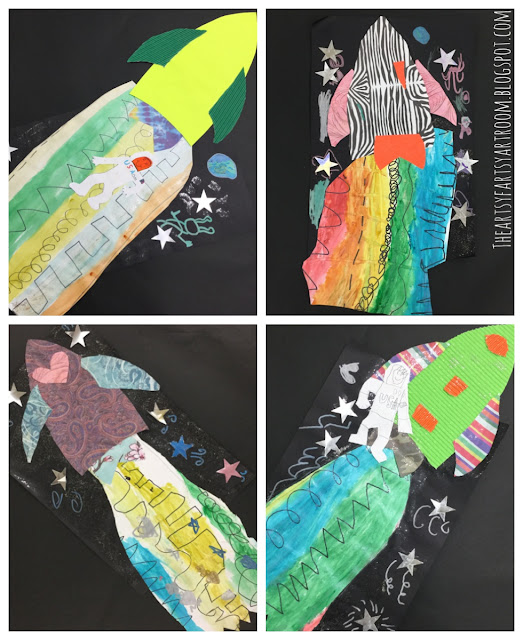This project (inspired by Art with Mr. E's) is officially one of my new favorites for K&1. It was a great review for lines and a super fun exploration of materials!
I Can identify different types of lines.
I Can explore many different materials.
Day 1: Reviewing lines. Line paintings.
Lines are one of the first things we visit in the year so I love doing a refresher project on them at the end of the year. To kick this project off I drew a picture on the SMART Board that contained all the lines they learned previously and they took turns coming up and finding them. Then we did some whole body fun by having groups of students make the different types of lines with their bodies! Just an observation: my classes that were most behaviorally challenging ended up doing the best with this activity.
 |
| Dashed and Zig-Zag |
 |
| Castle and Thick Line |
Day 2: Building Rocket Ships. Assessment.
Tracers. I always go back and forth on using them or not. But, an old principle (and art department head) once told me that as long as the learning goal isn't creating that specific shape they are ok. So, that's what I did. Each part of the rocket ship had a tracer: the main body, the wings, and the booster. After they watched my demo video on using the tracers and gluing the pieces together I let them run wild with a huge variety of papers with different textures and patterns. This was our second material that they explored.
Because the process of building the rockets was very independent, I used this time to pull students over to me for a verbal assessment to identify the different types of line. I had the lines drawn on a piece of paper and they went through and named as many as possible. Each student took about 30 seconds or less which made a very quick and easy assessment. The one little bump was a student would come over to ask me something while I was assessing another and they would spit out the answer before the kiddo getting assessed could answer.
We started the day talking about creating the rocket stream out of their line paintings. Again they watched my demo video and brainstormed the different shapes the stream could be and how it was okay if we cut some of our lines off. Then they added their rocketship to black paper and added some amazing details with our last material exploration -- metallic markers. I pre-punched stars on metallic paper that they could add as well and more tempera glitter paint. One last option for them was adding an astronaut. Again, I provided a tracer. The success rate overall on this project was so high and each was its own beautiful individual work of art with so much personality showing through.
Below are detail pictures...I was so blown away by some of these kiddos!!!!





















